
Crucial P1 SSD Review: Crucial's First NVMe SSD
Introduction

Recently Crucial released the P1 which is the company's first NVMe PCIe SSD that utilizes Micron’s QLC NAND technology to deliver high capacity for less. There are four types of NAND flash technologies. The first one is SLC which is 1 bit per cell and is the fastest and most expensive NAND to produce. Then we have MLC which is 2 bits per cell and is also quite expensive to produce. Then we have TLC which is 3 bits per cell and is the most used NAND in entry level SSDs because it is cheap to produce. Finally there is QLC which is 4 bits per cell and is the slowest and cheapest NAND to produce. QLC NAND is designed to close the gap between hard drives and flash storage by delivering high speeds and capacities at a much more affordable prices.
Crucial's P1 series feature a 5-year limited warranty and retail for $110 for the 500GB version and $220 for the 1TB version. Crucial has also announced a 2 TB version which will be available at a later date which we expect to cost around $450. In this review, we will focus on the Crucial P1 1TB model. Crucial advertises the P1 1TB with sequential read speeds of up to 2000 MB/s and sequential write speeds of up to 1700 MB/s and with a mean-time-to-failure (MTTF) of 1.8 million hours. Random 4K (IOPS) read speeds is rated for up to 170K IOPS and 240K IOPS for random 4K (IOPS) write speeds.
NVMe (Non-Volatile Memory Express) is a new hardware protocol for SSDs designed to replace AHCI. AHCI is an old hardware interface that was created back in the days when hard drives were popular but it's also used today with modern SATA SSDs such as the Crucial MX500 and Samsung 860 Evo. When an SSD uses the AHCI interface, that means that the read/write speeds will be limited by the bandwidth of the SATA 6 Gbps standard which is around 530MB/s read and 500MB/s write while NVMe SSDs on the other hand are able to provide read/write speeds as high as 3500MB/s read and 2500MB/s write.

Micron is using the Silicon Motion SM2263ENG controller backed by Micron's low-power DDR3 memory. The Silicon Motion SM2263ENG controller features four 8 Gbps lanes (PCIe Gen3 x4) coupled with four NAND channels. Feature-wise, the P1 NVMe SSDs come with Adaptive Thermal Protection, TRIM support, garbage collection and Dynamic Write Acceleration technology which accelerates sequential read and write speeds.
Pricing & Endurance
Micron's 3D-NAND technology is built to endure 100TB (TBW) for the 500GB model which equals to about 54GB daily read/write per day for 5 years. The 1TB and 2TB models can handle up to 200TB and 400TB (TBW) and this amounts to 109GB daily read/write for the 1TB model and 219GB for the 2TB model for 5 years. While QLC provides more density per NAND cell, the only issue with QLC is the reduced endurance which at the end of the day is not a big deal because the average user won't be writing 54GB per day or 109GB for the 1TB model.
A few months ago, we reviewed the Samsung 970 EVO which is one of the fastest NVMe SSDs out there but it comes at a premium price which most people cannot afford. The Samsung 970 EVO and Crucial P1 are designed for different needs. Samsung's 970 EVO is designed to deliver high performance while the Crucial P1 on the other hand is designed for people who want a high capacity drive at a low cost. So instead of comparing these two drives together, we will compare the Crucial P1 to a traditional SATA SSD such as the Crucial MX500 and Samsung 860 Evo.
Price is where the Crucial P1 truly shines. You will find the P1 1TB for around $220 on Amazon while something like the Samsung 970 Evo 1TB retails for $280 which is significantly more expensive. On Amazon, the Samsung 970 Evo 500GB retails for $150 while the Crucial P1 500GB sells for $110 which makes the P1 500GB about $40 cheaper. In the real world, you would never be able to tell the difference between these two drives so if you don't care about having the fastest drive on the market, the Crucial P1 drive is a good choice.
Features
The Crucial P1 supports many advance features such as Self Monitoring and Reporting Technology (SMART) which is basically a monitoring system used to perform an analysis of the drive for problems with the intent of anticipating hardware failures. It also supports garbage collection which is a form of automatic memory management that works by reclaiming previously written blocks of data so they can be rewritten with new data. TRIM support is included as well which basically means the operating system can inform the SSD which blocks of data are no longer in use and can be wiped internally.
Most SSDs utilize SLC Write Cache to boost write performance which is normally a fixed SLC cache size but the P1 uses a hybrid Dynamic Write Acceleration (DWA) which dynamically shrinks or grows the SLC cache size depending on the amount of data stored on the flash. The SLC cache size varies based on the capacity of the SSD but with the Dynamic Write Acceleration technology, a part of the NAND memory acts as SLC memory (one bit per cell) and this portion of the NAND memory acts as a specific buffer through which all data write operations pass.
The Silicon Motion SM2263ENG controller supports AES 256-bit hardware-based encryption which can be used to keep your personal files and confidential data restricted from hackers and thieves but unfortunately, Crucial has chosen to disable this feature on the P1 drive to keep the cost down . Being hardware-based means that the encryption engine secures your data without the performance degradation that you may experience with software-based encryption. The Crucial P1 also supports a technology called Multistep Data Integrity Algorithm which is a built-in feature of the NAND that protects your data if your system suddenly shuts down.
These are all the advanced features the Crucial P1 SSD supports:
- Garbage Collection
- TRIM Support
- Dynamic Write Acceleration
- Self-Monitoring and Reporting Technology (SMART)
- Redundant Array of Independent NAND (RAIN)
- Adaptive Thermal Protection
- Multistep Data Integrity Algorithm
Specifications
| Crucial P1 Series | ||||
|---|---|---|---|---|
| Model | 500GB | 1TB | 2TB | |
| Price | $110 | $220 | ??? | |
| Interface | PCIe Gen 3.0 x4 | |||
| Protocol | NVMe 1.3 | |||
| Form Factor | M.2 2280 | |||
| Dimensions | 80 x 22 x 2.38 mm | |||
| Controller | Silicon Motion SM2263ENG | |||
| DRAM (DDR3L) | 512MB | 1GB | 2GB | |
| NAND | Micron 64-layer 3D QLC | |||
| Sequential Read | 1,900 MB/s | 2,000 MB/s | ||
| Sequential Write | 950 MB/s | 1,700 MB/s | 1,750 MB/s | |
| 4KB Random Read (IOPS) | 90K IOPS | 170K IOPS | 250K IOPS | |
| 4KB Random Write (IOPS) | 220K IOPS | 240K IOPS | 250K IOPS | |
| Endurance (TBW) | 100 TB | 200 TB | 400 TB | |
| Operating Temperature | 0°C to 70°C | |||
| Life Expectancy | 1.5 Million Hours | |||
| Usage Application | Client PCs | |||
| Activate Power Usage | 100mW | |||
| TRIM supported | Yes | |||
| Hardware Encryption | No | |||
| Firmware | P3CR010 | |||
| Warranty | 5 Years | |||
| Launch Date | October 2018 | |||
Packaging
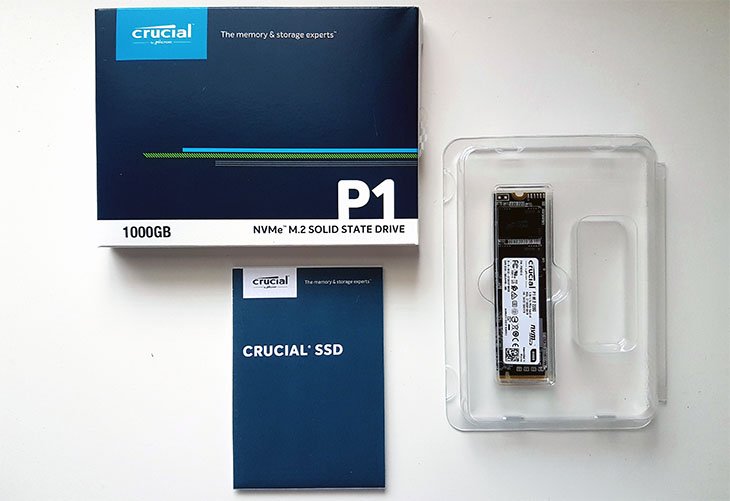
Crucial's P1 packaging remains the same as their SATA SSD packaging. The packaging of the P1 has a white strip on the front which lists the capacity size and the NVMe M.2 interface located at the bottom right corner. On the back you will find similar information such as model, serial number, capacity and warranty information in varies languages. Crucial includes the Acronis True Image HD software for transferring data from your old drive to your new P1 SSD which can be redeemed online.
You can download the Crucial Storage Executive software which can be used to enhance the performance of your SSD by allowing you to update the firmware, over-provision, secure-erase, and track the health of the SSD as well as see how much storage you’ve used. To configure your OS to work best with an SSD, you can disable index searching, prefetch, and superfetch because they are not needed if you are using an SSD I would also set the power options to high performance in Windows.
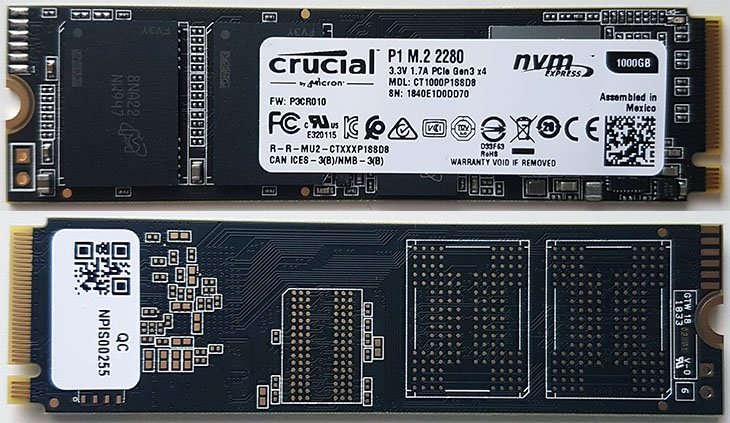
Silicon Motion's controller is enclosed inside a nickel-coated heatspreader to help dissipate heat more efficiently. Crucial has included Adaptive Thermal Protection technology which ensures that the P1 operates at optimal temperatures without overheating. As you can see from the picture above, the P1 1TB SSD is single-sided so there aren't any components on the back. You will find the Silicon Motion controller and a DRAM chip next to it which basically provides the SSD controller with RAM. The 500GB model uses 512MB DRAM cache buffer while the bigger 1TB and 2TB models come with 1GB and 2GB DRAM cache buffer, respectively.
Test Methodology
| Test Setup | |
|---|---|
| Processor: | AMD Ryzen 7 2700X (3.8Ghz) |
| Motherboard: | MSI X370 xPower Titanium (BIOS v1E) |
| RAM: | Ballistix Elite 16GB (2x8GB) DDR4 3200 MHz |
| Graphics Card: | Nvidia GeForce GTX 1070 |
| Storage: | Crucial P1 1TB Samsung 970 Evo 500GB Western Digital Black 3D 500GB Samsung 860 Evo 500GB Crucial MX500 1TB Crucial MX500 500GB Crucial BX300 240GB Crucial BX300 480GB Crucial MX300 525GB Crucial MX300 1TB Toshiba TR200 480GB Samsung 850 EVO 500GB Samsung 850 EVO 250GB Samsung 850 Pro 512GB |
| Power Supply: | Seasonic Focus Plus 750W Gold |
| Heatsink: | Noctua NH-D15 |
| OS: | Windows 10 Pro 64-Bit |
| Thermal Compound: | Noctua NT-H1 |
| Case: | Fractal Define Nano S |
To make sure these drives perform at their maximum performance, we will be disabling all the power saving features in the BIOS (C6-state, etc). The testing was done on a fresh install of Windows 10 64-bit with the latest windows updates installed. We disabled a bunch of unnecessary services such as drive indexing, Prefetch, Superfetch, Defrag and removed all the bloatware from Windows 10 to make sure there were as few processes running as possible during the testing.
We'll be using the AMD Ryzen 7 2700X processor overclocked to 3.8Ghz and the MSI X370 xPower Titanium motherboard
with the latest BIOS version which at the time of writing this is v1E.
Installing and using an NVMe SSD is pretty straight forward, simply connect your NVMe SSD to the M.2 port
in your motherboard. After you have installed it, make sure to check for firmware update.
Benchmark Software:
+ Windows 10 Startup
+ HD Tune Pro
+ ISO File Copy
+ AS SSD Read/Write
+ AS SSD Score
+ IOMeter
Benchmark Results
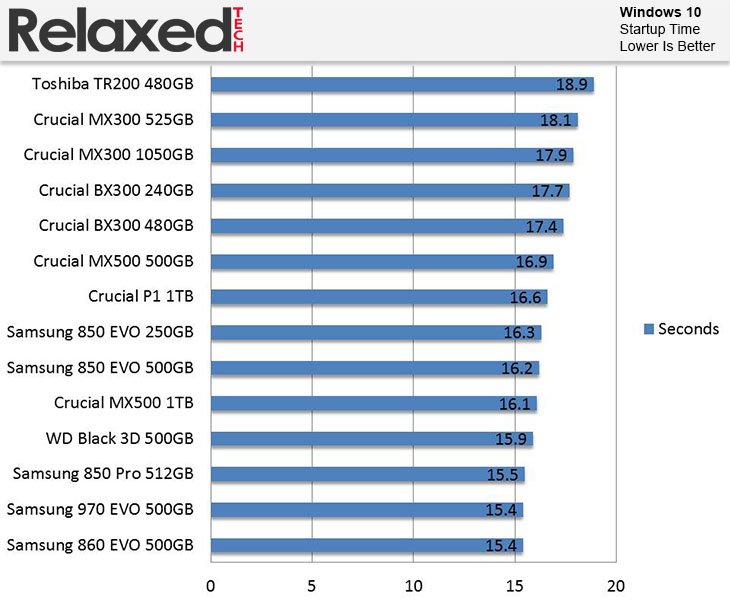
Windows 10 boot times are measured from the time it takes between hitting the power button to reaching the Windows desktop.
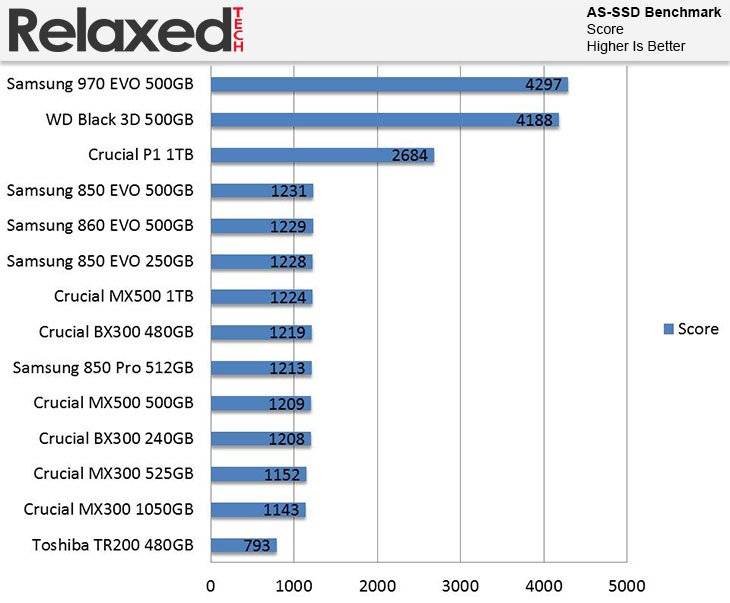
The AS-SSD software is a popular benchmarking software used to measure the performance of an SSD. In this test we are measuring the overall score.
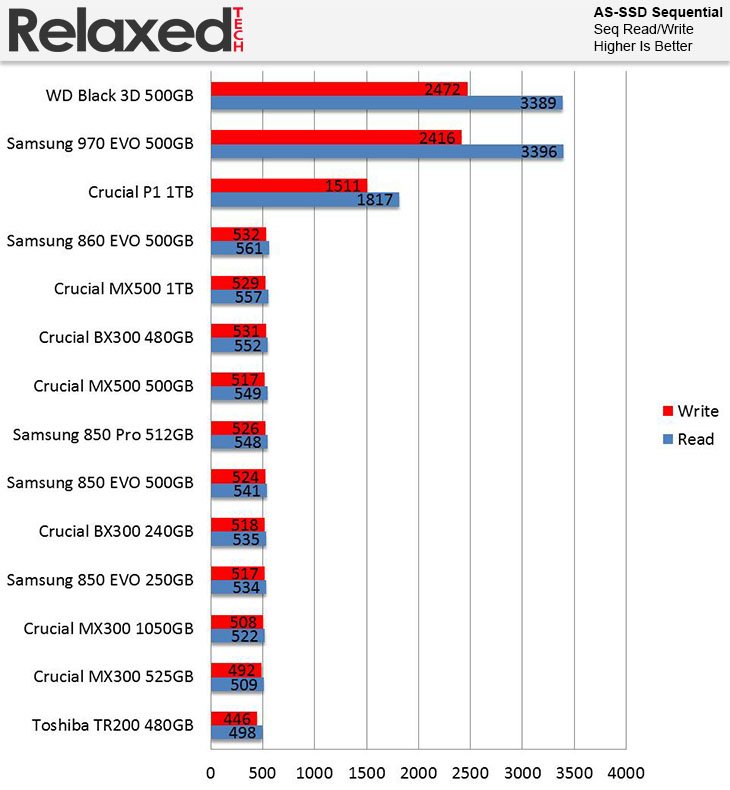
Once again, we are using the AS-SSD software to measure sequential read and write speed of each drive.
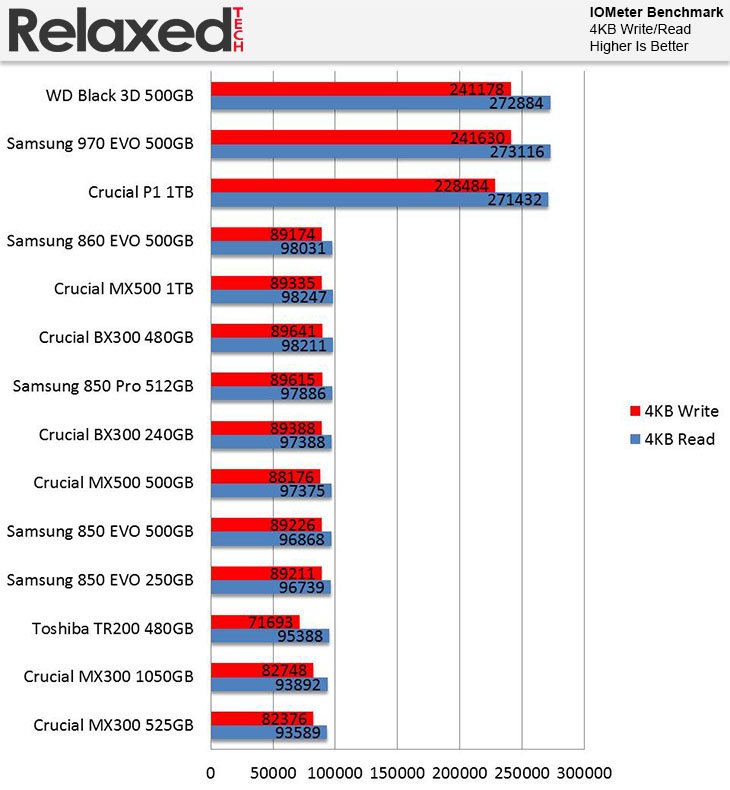
In this test, we are using IOMeter which is one of the best application for stress testing the random IO performance of an SSD. IOMeter is set to use 4KB file size chunks and will stress the SSD with random 4 KB files.
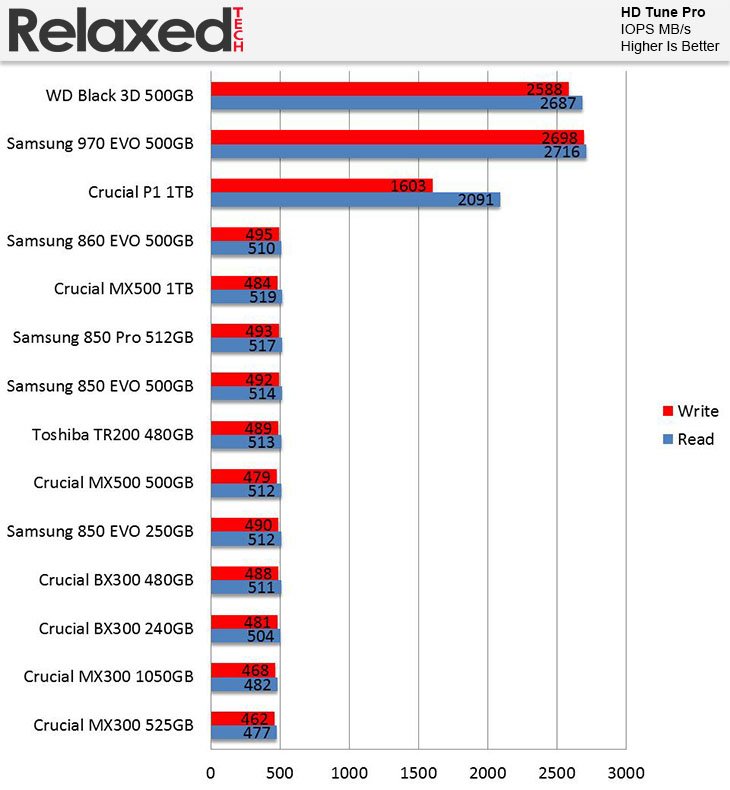
Here we are using HD Tune Pro to measure read and write IOPS. HD Tune Pro is a Hard Disk Utility with many functions such as error checking, S.M.A.R.T and benchmarking.
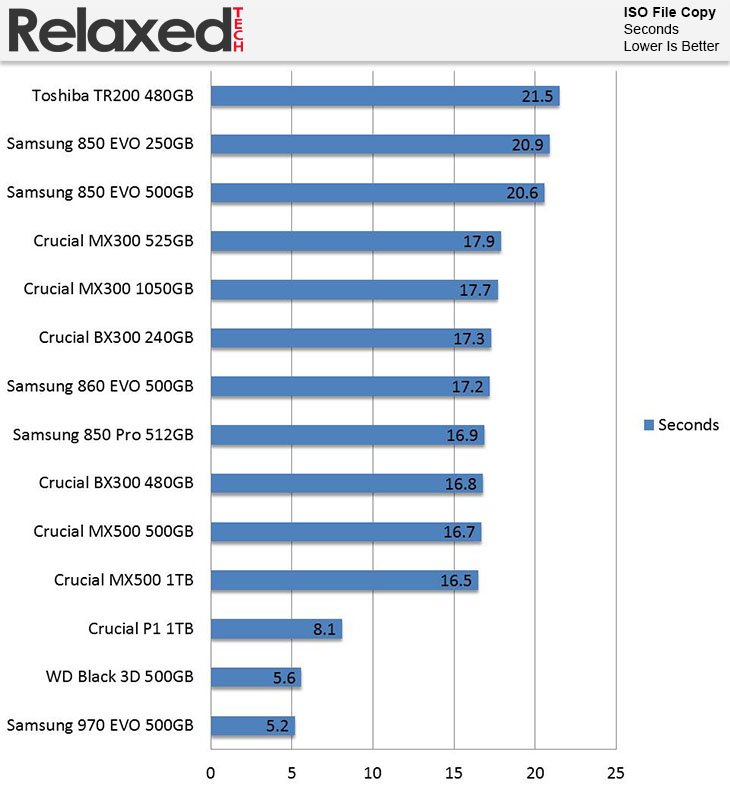
To represent a large file usage scenario, we are copying a 10GB ISO image to a different folder on the same drive.
Conclusion
Crucial's P1 1TB is a great budget NVMe drive that offers fantastic performance at an affordable price.
It comes loaded with plenty of attractive features such as Dynamic Write Acceleration, Adaptive Thermal Protection and Multistep Data Integrity Algorithm.
If you are using a traditional hard drive, definitely consider upgrading to an NVMe SSD like the P1
because it will offer a massive upgrade in every aspect from read/write speeds to boot times.
Pros:
+ Much Faster Than SATA SSD
+ Free Acronis True Image Software
+ Up To 2TB Capacity
+ Attractive Price
+ Five-Years Warranty
Cons:
- Low Write Speeds
- Lacking Hardware Encryption
Crucial's SSDs have always been competitively priced compared to the competition and the P1 is no exception.
At $220, the P1 1TB costs about $60 less than the 970 EVO 1TB which retails for $280.
Sure, the 970 EVO 1TB is much faster but at the end of the day, you will not feel the difference whether you are gaming,
browsing the web or watching movies.
If you are on a budget, we recommend going with the Crucial P1 drive since it offers great performance at an attractive price but
if money is not an issue for you, then the 970 EVO is an excellent choice.
So if you are looking for a large capacity NVMe drive at a low price while at the same delivering great performance, the Crucial P1 should definitely be on your radar. Another thing that I like about Crucial P1 SSD is that it comes with the Acronis True HD Image software which can come in handy if you want to clone your drive. I'm also a big fan of the Crucial Storage Executive software because it is easy to use and helps optimize the performance of your Crucial SSD. Overall, I believe the Crucial P1 1TB NVMe SSD deserves our recommended award.
Final Score 9.0
